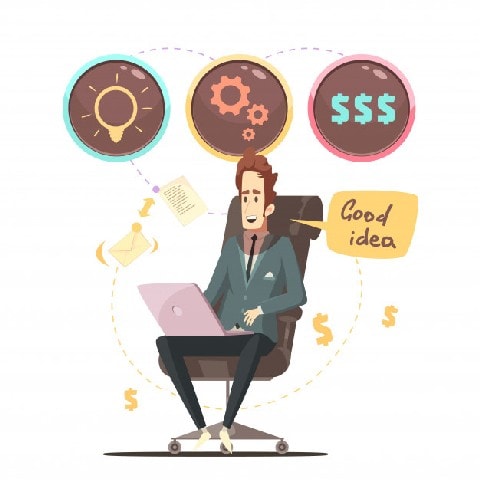Table of Contents
Definition
Equity theory is a concept where people want the ratio of their outcomes to be nearly equivalent to the ratio of a referent person or a group. It the ratio is not equal, then emotional responses will occur that will result in the restoration of equity by itself.
As per the equity theory, human beings derive motivation and satisfaction in a job by comparing their inputs and outputs with other people in either the same or some other firm.
What is Equity Theory?
Equity theory refers to the fact that human motivation, to a great extent, depends on what he considers fair and is correlated with his perception of justice practiced by the management. In an organization, it is about the work compensation of an employee and his attempts in minimizing supposed unfairness. He seeks to balance the amount of effort he puts in with the compensation he receives for it.
If equity theory is implemented, then there is transparency in cause and effect, and every person is aware of the rewards and consequences. With equity in place, individuals have equal chances of opportunities, and this leads to a beneficial work environment for both the employees and employers.
Understanding equity theory
Equity theory is all about striking the right kind of balance between the input and output of an employee in the workplace because such a scenario will lead to a productive relationship with the management.
In a business setting, both the employer and the employee wants to be sure that his action is rewarded, the employee with pay and praise and employer with profit and productivity. If the relationship is equitable, then both should be happy and satisfied at the end of the day.
As per Adam’s theory
Individual’s outcomes / Individual’s own inputs = Relational partner’s outcomes / Relational partner’s inputs
In case the output-input ratio of an individual is equal to the ratio of the referent partner, the employee will feel motivated, and this feeling is termed as Perfect Equity.
In case the output-input ratio of an individual is less than the ratio of the partner, the employee will feel de-motivated and under-rewarded. This feeling is termed as Equity Tension.
In case the output-input ratio of an individual is more than the ratio of the referent partner the employee will feel over-rewarded and again this feeling is termed as Equity tension
Equity theory tries to determine whether resource distribution has been fair to both relational partners and whether justice has been served or not in the eyes of an employee. The theory states that people who are over rewarded and under-rewarded will feel distressed, and this feeling nudges them to restore equality within the relationship.
Examples of Equity Theory
It is easy to understand the concept of equity theory by looking at some common examples that occur in our everyday life. People use comparable reference even without realizing what they are doing. It seems is earning more than me even though the number of hours I spend in the office is more than hers.
My perception is based on the fact that I am working more hours and thus should be paid more, but the management believes that the work done by Seems is more critical, and hence she deserves better pay. It is all about perception and assumptions and can tilt either way depending upon the viewpoint of an individual.
Meaning of equity
Equity has two main elements inputs and outputs or outcomes, which are described in detail.
Inputs
Inputs are described as the contribution of a participant towards relational exchange and can be assets that entitle him to reward or liabilities that give the right to costs. The entitlement to each input varies and is, to a great extent, dependent on a relational setting.
In social settings, kindness and physical beauty are seen as assets and cruelty is seen as a liability, whereas in industrial settings manual labor and capital is seen as inputs that entitle the contributor to reward. Some examples of input are
- Skill
- Support from colleagues
- Trust in superiors
- Any personal sacrifices made
- Enthusiasm showed
- Tolerance
- Adaptability
- Determination
- The flexibility showed by a person
- The ability of an individual
- Commitment is shown
- The loyalty of a person demonstrated towards seniors or the company
- Hard work
- Duties and responsibilities of an individual in the role
- Effort
- The experience brought to the role
- Education
- The time or the numbers of hours worked
Outcomes or outputs
Outcome or output is described as negative as well as positive consequences that a participant perceives has incurred as a result of his relationship with another. The outputs can be intangible and tangible, and some common examples are
- Praise
- Bonus
- Responsibility
- Reputation
- Pension
- Stimuli
- Annual holiday allowance
- Thanks
- Sense of achievement
- Company car
- Recognition
- Expenses
- Stock options
- Employee benefit
- Sense of achievement
- Improved reputation
- Salary
- Promotion
- The flexibility of work arrangements
- Learning
- Performance appraisals
- Job security
- Praise from co-workers
- Pride in one’s work
Assumptions in business applications
The critical assumptions of equity theory, when applied to business applications, are as follows-
- Employees in a business organization expect “equity norm”, a concept that declares expectation of fair return against the contribution of an employee to the job
- The equity theory demonstrates that people are concerned with their rewards and also about what others are getting in comparison
- It is the employees that will determine what an equitable return should be. This is after making a viable comparison between their input and outcomes with those of the other employees or colleagues. This concept is referred to as “social comparisons”.
- A key assumption is that the employees who feel are in an inequitable position will try to minimize the perceived inequity via twisting outcomes or inputs in their minds by altering outputs/inputs or by leaving the company.
Key points for business managers
The key aspects of equity theory or implications for business managers are as follows-
- Individuals often measure the input and outcome as a total or sum, for example, a person who is looking for a stay-at-home job may accept lower compensation in monetary terms for flexibility in working place which has shifted from office to residence
- Employees will be ready to make viable adjustments for local market conditions and the purchasing power of that place. If a person is living in Kolkata, he may accept lower compensation compared to his colleague who stays in Bengaluru because the cost of living is quite different in that place
- Human nature is different, and two employees will put personal values as per their perception of the inputs and outcomes. For example, if two employees of similar qualification perform the same work for equal pay, their perceived notion about fair pay can be different from each other
- It is acceptable to an employee of lower rank to see that senior staffs are receiving higher compensation, but there is a limit to his perceived fairness. If he feels that the balance is tilting in favor of the top employee inequitably, then he will see the pay as de-motivating
- The perception of employees in terms of inputs and outcomes of themselves compared to others might be incorrect, and it becomes essential to manage these perceptions effectively.
- If an employee believes that he is overcompensated, he will increase his efforts. In some cases, he might adjust the value he puts on personal input and because of a sense of superiority try to reduce his efforts
It is essential to mention that a manager has several options available to him for minimizing inequity for instance
- Change the input or output of an individual
- Change the input or output of others
- Change the perceptions of inputs and outputs
The employees who perceive inequity have the following options available to them
- Change in input
- Choose a different referent
- Change self-perception
- Change their outcome
- Quit the current job
- Change the perception of others
Propositions
The four propositions of equity theory are as follows-
1. Self-inside
The first proposition of equity theory is self-inside which states that the people always are on the look-out to increase their outcomes to maximum levels in a situation where the result is defined as rewards fewer costs
2. Self-outside
The second proposition of equity theory is self-outside which states that the groups can increase their collective rewards to the maximum level by developing accepted norms for impartially allocating costs and rewards among the group members.
The equity theory will be seen in a group where members will try to influence others to accept the system by making it more profitable to behave in an equitable manner than in an inequitable way. The groups will ultimately reward members who are treating others in an equitable manner and punish those who do not.
3. Others-inside
The equity theory categorically states that if people are in an inequitable relationship, they feel distressed, and this is applicable for both individuals who either get too little or too much. The person who gets too little feels humiliation and anger whereas the one who gets too much feels shame or guilt.
4. Other-outside
As per the equity theory, people who feel they are in an inequitable relationship try to remove the feeling of distress by restoring equity. The bigger the margin of equity, the more distress they will feel and more is their effort in restoring the said equity.
Moderating variables
The education, salary, gender and experience level are some of the important moderating variables. It can have a direct impact on the perception of fairness of a person for instance if a person of high experience may have connected with a large number of people over the years and this could urge him to make an other-outside comparison.
If a person has more experience inside his firm, he is going to make more inside comparisons. It is a fact that males and females prefer comparisons with same-sex because they are more comfortable relating to their same-sex as a point of comparison.
Advantages of Equity Theory
The advantages of equity theory are as follows
1. Motivation
Implementation of the equity theory in a workplace offers numerous opportunities to the employees, and this motivates them to achieve by grabbing viable chances. The workforce is sure of the fact that the rewards will be per the effort and hence, they try to make a distinguishing mark. Equity theory can motivate the employees and ensure a culture of achievement.
The advantage of equity theory is that when employees are offered promotion and bonus in a job where equitable rewards meet merit, the organization can place the right person in the right job profile and it leads to employee motivation
2. Employee retention
when employees are motivated, they want to stay in a company. They believe that they have a bright future over here and they are thus eager to claim the rewards.
An essential advantage of implementing equity theory in a company is employee retention because employee motivation and satisfaction will lead to employee retention.
3. Cost-cutting
Implement equity theory in a company that cuts down organizational expenses to a higher degree, and this is one of its advantages. Employee retention results in saving undue costs in the form of brain drain or training expenses that a company has to bear when it hires new employees
4. Attracting talent
Organizations that implement the concept of equity theory in their work find it easy to attract talent because every employee wants to be associated with a firm that believes in fair treatment. Employees do not want to worry about a hidden agenda that can lead to bias or preferential treatment for some of the elite workforce.
They are sure in an environment that fosters equity theory because it means that dedication and effort pays off and the potential employees will get to work with other achievers
5. Breadth by diversity
Diversity in a workplace is seen where the company believes inequitable behavior. Here every employee has access to equal opportunities, and this is a significant advantage for a firm because it gains intellectual capital and breadth via diversity
6. Increased bottom line
One of the advantages of implementing equity theory is that it can draw top talent, foster high morale amongst employees and makes the firm competitive leading to an increased bottom line in the financial statement.
7. Aids in minimizing exploitation
An essential advantage of equity theory is that it minimizes the exploitation of the employees. There is no discrimination between workers in terms of working conditions, pay or bonus.
8. Better relation between employees
When employees are aware that the firm has implemented the concept of equity theory and they will be getting what is due to them without any discrimination then it results in better relationships between employees because no one is jealous of the other employees in that firm.
Disadvantages
The disadvantages of equity theory are as follows-
1. The difference in perception
One of the most important disadvantages of equity theory is that there is a difference in opinion about perception. It can be between an employer and employee and also between different employees in the organization.
2. Exact comparison is impossible
Employees are comparing their inputs and outcomes with other employees in the same as well as other organizations. There are lots of variables involved, and it is not always easy to make viable comparisons between any person, product or service. This is a severe disadvantage and stops the concept from being fully effective
3. All other factors are ignored
There are several factors involved while making comparisons. Equity theory is all about perception and input and outcomes. All the other related factors are ignored, and this becomes a severe disadvantage to it.
4. Does not predict everything
An essential disadvantage of equity theory is that it does not make any predictions about overpayment conditions and how employees or individuals are going to handle those specific conditions. It also does not take into account the individual differences that have a direct impact on equity.
What happens when inequity persists?
When inequities persist in a workplace, the employees are liable to
- Quit the job
- Become too competitive and try to minimize the output of other employees
- Become resistant and act out on several other issues
- Go into survival mode and make sure that they are just going through the motions and doing their job and a little more
- Demand for increased output from the organization, for instance, more authority and increased pay
- Changing the point of comparisons to minimize discomfort
- The employee will try to decrease input by doing less amount of work or giving less time to the job
- Changing the reward that the employee receives by asking for a better treatment
These outcomes are bound to cause harm to the bottom line of a company and can affect both talent and economy. When employees believe that inequity is persisting and the workplace is making unfair decisions, they start distrusting the leadership, and in case the distrust is ignored by the leaders, then it has a direct impact on employee motivation, morale, and satisfaction.
Tips for workplace
Some essential tips for applying equity theory in the workplace are as follows-
1. Ensuring a fair balance between team members
Set up standards for equality and fairness so that all the employees get the same compensation for equal work. The employees will make work contributions based on their perception of the benefit they will get, and when the set standard is similar then, it will ensure fair balance and justice between team members.
It is imperative to hold regular team meetings so that every effort feels valued if you are looking for tips to apply equity theory in the workplace
2. Knowing what the team values the most
Team members are sure to place a different set of values on inputs and outcomes. Some might consider training and skills with high-value quotient, whereas others might perceive effort should be rewarded more.
Ask individual members what they value most if you are looking for tips to implement equity theory in the workplace. Show that the contributions of team members are appreciated relatively so that the employees can be happy and stay motivated in their workplace surroundings.
3. Offering comparable balance
The basis of comparisons can be set on both inside and outside the workplace. Offer comparable balance if you are looking for tips to implement equity theory in the workplace. Research and find viable information about incentives, benefits, and salaries for employees in outside settings and set similar parameters in your firm.
When the employees see that they are receiving similar outcomes compared with other employees in their field that have the same experience, they are going to feel satisfied and will stay in their position for a more extended period.
What can you do to stop inequity at work?
The steps that can stop inequity at the workplace are as follows-
1. Reviews
The employees must be aware of how often their company is going to perform salary reviews. Send the information for review meeting beforehand so that they are aware that their employers are thinking about salary up-gradation and performance reviews.
A critical advantage o sending this notice is that the employees will be able o regain lost motivation and try new things to make an impact. The common ones are-
- Review when you have achieved a promotion
- Review after you have completed the probation period
- Yearly performance and the salary review
2. Open door policy
If an organization is trying to stop inequity at work, it can implement an open door policy. Make sure that every employee is aware of the open-door policy and can come and speak to management about any issues
3. Employee assistance program
Implement an employee assistance program or EAP so that employees can have the option to access 24*7 support from professionals who are ready to offer a helping hand. This will ensure that the employees are at their best and can then perform to their strengths. Healthy workplace results in a pleasant ambiance and optimistic employees.
Liked this post? Check out the complete series on Human resources





